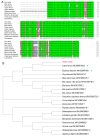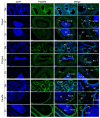Exploring the Molecular Characteristics and Role of PDGFB in Testis and Epididymis Development of Tibetan Sheep
- PMID: 38922013
- PMCID: PMC11209412
- DOI: 10.3390/vetsci11060266
Exploring the Molecular Characteristics and Role of PDGFB in Testis and Epididymis Development of Tibetan Sheep
Abstract
Platelet-derived growth factor B (PDGFB), as an important cellular growth factor, is widely involved in the regulation of cellular events such as cell growth, proliferation, and differentiation. Although important, the expression characteristics and biological functions in the mammalian reproductive system remain poorly understood. In this study, the PDGFB gene of Tibetan sheep was cloned by RT-PCR, and its molecular characteristics were analyzed. Subsequently, the expression of the PDGFB gene in the testes and epididymides (caput, corpus, and cauda) of Tibetan sheep at different developmental stages (3 months, 1 year, and 3 years) was examined by qRT-PCR and immunofluorescence staining. A bioinformatic analysis of the cloned sequences revealed that the CDS region of the Tibetan sheep PDGFB gene is 726 bp in length and encodes 241 amino acids with high homology to other mammals, particularly goats and antelopes. With the increase in age, PDGFB expression showed an overall trend of first decreasing and then increasing in the testis and epididymis tissues of Tibetan sheep, and the PDGFB mRNA expression at 3 months of age was extremely significantly higher than that at 1 and 3 years of age (p < 0.05). The PDGFB protein is mainly distributed in testicular red blood cells and Leydig cells in Tibetan sheep at all stages of development, as well as red blood cells in the blood vessel, principal cells, and the pseudostratified columnar ciliated epithelial cells of each epididymal duct epithelium. In addition, PDGFB protein expression was also detected in the spermatocytes of the 3-month-old group, spermatids of the 1-year-old group, spermatozoa and interstitial cells of the 3-year-old group, and loose connective tissue in the epididymal duct space in each developmental period. The above results suggest that the PDGFB gene, as an evolutionarily conserved gene, may play multiple roles in the development and functional maintenance of testicular cells (such as red blood cells, Leydig cells, and germ cells) and epididymal cells (such as red blood cells, principal cells, and ciliated epithelial cells) during testicular and epididymal development, which lays a foundation for the further exploration of the mechanisms by which the PDGFB gene influences spermatogenesis in Tibetan sheep.
Keywords: PDGFB; development; epididymis; sheep; testis.
Conflict of interest statement
The authors declare no conflicts of interest.
Figures








Similar articles
-
Cloning, Molecular Characterization and Expression Patterns of DMRTC2 Implicated in Germ Cell Development of Male Tibetan Sheep.Int J Mol Sci. 2020 Apr 1;21(7):2448. doi: 10.3390/ijms21072448. Int J Mol Sci. 2020. PMID: 32244802 Free PMC article.
-
Distinct expression and localization patterns of HSP70 in developmental reproductive organs of rams.Gene. 2020 Nov 15;760:145029. doi: 10.1016/j.gene.2020.145029. Epub 2020 Aug 3. Gene. 2020. PMID: 32758578
-
Characterization of GLOD4 in Leydig Cells of Tibetan Sheep During Different Stages of Maturity.Genes (Basel). 2019 Oct 12;10(10):796. doi: 10.3390/genes10100796. Genes (Basel). 2019. PMID: 31614839 Free PMC article.
-
Regulation of GDF9 and CDKN1B expression in Tibetan sheep testes during different stages of maturity.Gene Expr Patterns. 2022 Mar;43:119218. doi: 10.1016/j.gep.2021.119218. Epub 2021 Nov 23. Gene Expr Patterns. 2022. PMID: 34826605
-
Roles of connexins in testis development and spermatogenesis.Semin Cell Dev Biol. 2016 Feb;50:22-30. doi: 10.1016/j.semcdb.2015.12.019. Epub 2016 Jan 11. Semin Cell Dev Biol. 2016. PMID: 26780117 Review.
Cited by
-
Transcriptome and Metabolome Analyses Reveal High-Altitude Adaptation Mechanism of Epididymis Sperm Maturation in Tibetan Sheep.Animals (Basel). 2024 Oct 29;14(21):3117. doi: 10.3390/ani14213117. Animals (Basel). 2024. PMID: 39518841 Free PMC article.
-
Seminal Plasma Extracellular Vesicles: Key Mediators of Intercellular Communication in Mammalian Reproductive Systems.Vet Sci. 2025 Jun 13;12(6):585. doi: 10.3390/vetsci12060585. Vet Sci. 2025. PMID: 40559822 Free PMC article. Review.
References
Grants and funding
- [2024]13/Doctoral Fund of Guizhou Academy of Agricultural Sciences
- [2023]018/Special Funds for Central Guidance of Local Scientific and Technological Development in Gui-zhou Province
- 22JR5RA886/Youth Science and Technology Foundation of Gansu Province
- [2023]04/Guizhou Academy of Agricultural Sciences Germplasm Resources
LinkOut - more resources
Full Text Sources

